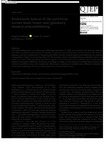Excitotoxic lesions of the perirhinal cortex leave intact rats’ gustatory sensory preconditioning
| dc.contributor.author | Robinson, J | |
| dc.contributor.author | Jones, Peter | |
| dc.contributor.author | Whitt, EJ | |
| dc.date.accessioned | 2021-12-02T17:06:17Z | |
| dc.date.available | 2021-12-02T17:06:17Z | |
| dc.date.issued | 2021-11-02 | |
| dc.identifier.issn | 1747-0218 | |
| dc.identifier.issn | 1747-0226 | |
| dc.identifier.uri | http://hdl.handle.net/10026.1/18436 | |
| dc.description.abstract |
<jats:p> We report findings from two sensory preconditioning experiments in which rats consumed two flavoured solutions, each with two gustatory components (AX and BY), composed of sweet, bitter, salt, and acid elements. After this pre-exposure, rats were conditioned to X by pairing with lithium chloride. Standard sensory preconditioning was observed: Consumption of flavour A was less than that of B. We found that sensory preconditioning was maintained when X was added to A and B. Both experiments included one group of rats with lesions of the perirhinal cortex, which did not influence sensory preconditioning. We discuss our findings in the light of other sensory preconditioning procedures that involve the perirhinal cortex and conclude that differences in experimental variables invoke different mechanisms of sensory preconditioning, which vary in their requirement of the perirhinal cortex. </jats:p> | |
| dc.format.extent | 1215-1227 | |
| dc.format.medium | Print-Electronic | |
| dc.language | en | |
| dc.language.iso | en | |
| dc.publisher | Routledge | |
| dc.subject | Sensory preconditioning | |
| dc.subject | associative learning | |
| dc.subject | perirhinal cortex | |
| dc.subject | stimulus representation | |
| dc.subject | Animals | |
| dc.subject | Conditioning, Psychological | |
| dc.subject | Humans | |
| dc.subject | Perirhinal Cortex | |
| dc.subject | Rats | |
| dc.subject | Taste | |
| dc.title | Excitotoxic lesions of the perirhinal cortex leave intact rats’ gustatory sensory preconditioning | |
| dc.type | journal-article | |
| dc.type | Journal Article | |
| plymouth.author-url | https://www.ncbi.nlm.nih.gov/pubmed/34623212 | |
| plymouth.issue | 7 | |
| plymouth.volume | 75 | |
| plymouth.publication-status | Published | |
| plymouth.journal | Quarterly Journal of Experimental Psychology | |
| dc.identifier.doi | 10.1177/17470218211054981 | |
| plymouth.organisational-group | /Plymouth | |
| plymouth.organisational-group | /Plymouth/Faculty of Health | |
| plymouth.organisational-group | /Plymouth/REF 2021 Researchers by UoA | |
| plymouth.organisational-group | /Plymouth/REF 2021 Researchers by UoA/UoA04 Psychology, Psychiatry and Neuroscience | |
| plymouth.organisational-group | /Plymouth/Users by role | |
| plymouth.organisational-group | /Plymouth/Users by role/Academics | |
| dc.publisher.place | England | |
| dcterms.dateAccepted | 2021-09-01 | |
| dc.rights.embargodate | 2021-12-7 | |
| dc.identifier.eissn | 1747-0226 | |
| dc.rights.embargoperiod | Not known | |
| rioxxterms.versionofrecord | 10.1177/17470218211054981 | |
| rioxxterms.licenseref.uri | http://www.rioxx.net/licenses/all-rights-reserved | |
| rioxxterms.licenseref.startdate | 2021-11-02 | |
| rioxxterms.type | Journal Article/Review |


